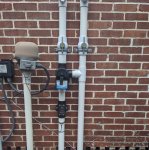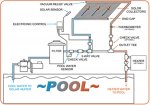While cleaning pool this weekend, I noticed decreased flowrate.
I have a spillover spa. Normally, there is spillover even at lowest pump RPM setting (1000). Currently, at 1000 RPM, I have no spillover nor is there water at pool return jets.
At 1000, the pump is running, but its clear no or very little water is flowing through the pump basket and SWG appropriately cuts off. Again, all of this changed compared to normal.
When I turn it up to 1500, I get water going over spillover, water at return jets, and SWG turns back on.
Checked the troubleshooting page on this site. Regarding operating pressure, when filter is clean and pump is running at 2750, my pressure is 15 PSI. Today pressure was 15.5. Cleaned the filter and pump basket, pressure back to 1500, but still no flow at 1000 RPM.
I didn't see or feel anything at pump inlet and tried to shoot water back up suction line with hose. No improvement, though I'll admit I'm not terribly handy, and I'm not exactly sure of what I'm supposed to feel.
2 other observations...I do have air in pump basket at low RPM but resolves at high RPM. I checked O-ring, seems ok.
Also have solar heating system. Even when solar is off, I hear water flowing through the solar plumbing. Could there be a check-valve problem?
Any suggestions?
I have a spillover spa. Normally, there is spillover even at lowest pump RPM setting (1000). Currently, at 1000 RPM, I have no spillover nor is there water at pool return jets.
At 1000, the pump is running, but its clear no or very little water is flowing through the pump basket and SWG appropriately cuts off. Again, all of this changed compared to normal.
When I turn it up to 1500, I get water going over spillover, water at return jets, and SWG turns back on.
Checked the troubleshooting page on this site. Regarding operating pressure, when filter is clean and pump is running at 2750, my pressure is 15 PSI. Today pressure was 15.5. Cleaned the filter and pump basket, pressure back to 1500, but still no flow at 1000 RPM.
I didn't see or feel anything at pump inlet and tried to shoot water back up suction line with hose. No improvement, though I'll admit I'm not terribly handy, and I'm not exactly sure of what I'm supposed to feel.
2 other observations...I do have air in pump basket at low RPM but resolves at high RPM. I checked O-ring, seems ok.
Also have solar heating system. Even when solar is off, I hear water flowing through the solar plumbing. Could there be a check-valve problem?
Any suggestions?



